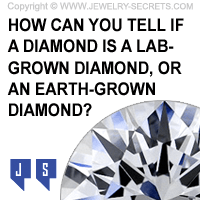HOW CAN YOU TELL IF A DIAMOND IS A LAB-GROWN DIAMOND OR AN EARTH-GROWN DIAMOND?
3 WAYS TO TELL THE DIFFERENCE BETWEEN LAB-GROWN DIAMONDS AND EARTH-GROWN
This post contains affiliate links. If you use these links to buy something I may earn a commission. Thanks! As an Amazon Associate I also earn from qualifying purchases.

Diamonds are one of the most precious and sought-after gemstones in the world. They are used in jewelry, as well as in industrial applications due to their exceptional hardness and durability.
However, not all diamonds are created equal (although they may look identical). Some diamonds are created in a laboratory, while others are formed naturally in the earth’s mantle. So let’s discuss how to tell if a diamond is lab-grown or earth-grown.
First and foremost, it is important to understand the key differences between lab-grown and earth-grown diamonds. Lab-grown diamonds are created in a controlled environment using advanced technology to mimic the natural process of diamond formation. These diamonds are made using high pressure and high temperature (HPHT) or chemical vapor deposition (CVD) methods. On the other hand, earth-grown diamonds are formed over millions of years deep within the earth’s mantle under extreme pressure and temperature.
Now, let’s take a look at some of the ways you can determine whether a diamond is lab-grown or earth-grown:
- Certification: One of the most reliable ways to determine whether a diamond is lab-grown or earth-grown is to check its certification. Most loose diamonds, whether they are lab-grown or earth-grown, are graded and certified by independent gemological laboratories such as GIA, AGS, and IGI. The certificate will clearly state whether the diamond is natural or lab-grown.
- Price: In general, lab-grown diamonds are less expensive than earth-grown diamonds (about 50% less). This is because lab-grown diamonds can be produced in larger quantities and more quickly than earth-grown diamonds. If the price of a diamond seems too good to be true, it may be a lab-grown diamond.
- Inscription: All lab-grown diamonds will have a laser inscription on the side of the girdle (usually visible only when using a 10x powered loupe or microscope) that will either say something like LG (for lab-grown), or actually have the word written out: lab grown. This same inscription number will be listed on the certificate. So make sure they match!
So you see, there are several ways to determine whether a diamond is lab-grown or earth-grown. While certification is the most reliable method, other factors such as price and inscription can also provide clues. It is important to note that both lab-grown and earth-grown diamonds have their own unique characteristics and can be equally valuable depending on their quality and rarity.
Check out these great diamond deals below:
Cheers! :)


















Leave a comment